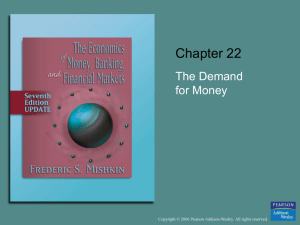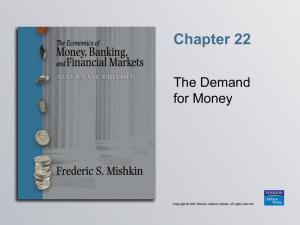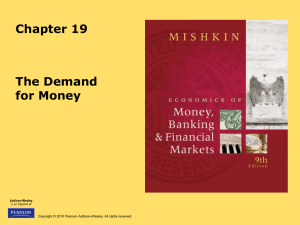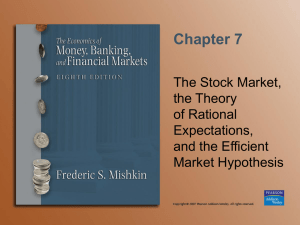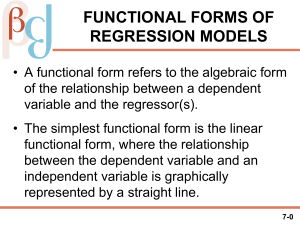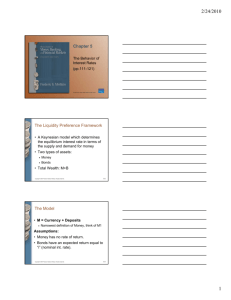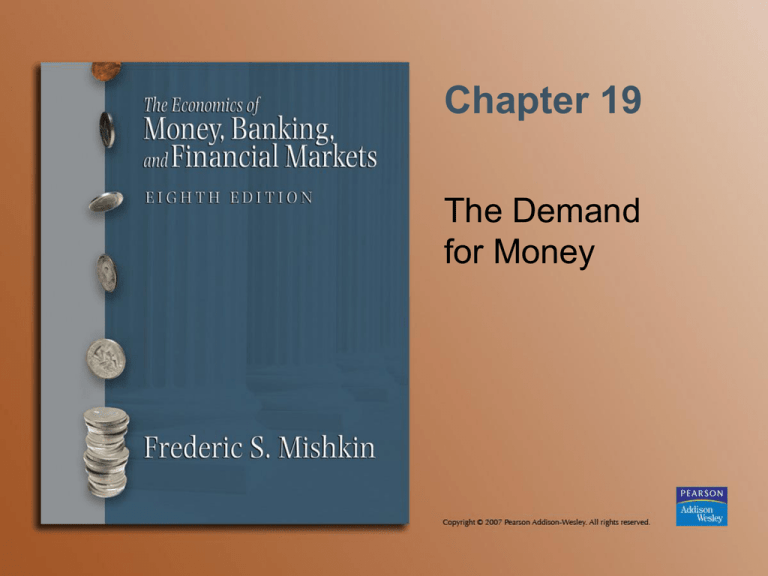
Chapter 19
The Demand
for Money
Velocity of Money
and Equation of Exchange
M = the m oney supply
P = price level
Y = aggregate output (incom e)
P Y aggregate nom inal incom e (nom inal G D P)
V = velocity of m oney (average num ber of tim es per year that a dollar is spent)
V
PY
M
E quation of E xchange
M V P Y
Copyright © 2007 Pearson Addison-Wesley. All rights reserved.
19-2
Quantity Theory
• Velocity fairly constant in short run
• Aggregate output at full-employment
level
• Changes in money supply affect only
the price level
• Movement in the price level results
solely from change in the quantity
of money
Copyright © 2007 Pearson Addison-Wesley. All rights reserved.
19-3
Quantity Theory of Money Demand
D ivid e bo th sid es by V
M =
1
PY
V
W h en the m o ney m arket is in equ ilibrium
M = M
L et k
d
1
V
M
d
k PY
B ecause k is co nstant, the level of tranactio ns g enerated by a
fixed level of P Y determ in es the quan tity of M
d
T h e dem and for m on ey is no t affected by interest rates
Copyright © 2007 Pearson Addison-Wesley. All rights reserved.
19-4
Copyright © 2007 Pearson Addison-Wesley. All rights reserved.
19-5
Keynes’s Liquidity Preference Theory
• Transactions Motive
• Precautionary Motive
• Speculative Motive
• Distinguishes between real and nominal
quantities of money
Copyright © 2007 Pearson Addison-Wesley. All rights reserved.
19-6
The Three Motives
M
d
f ( i,Y ) w h ere the dem and fo r real m o n ey b alances is
P
n eg ativ ely related to th e in terest rate i,
an d p o sitiv ely related to real inco m e Y
R ew riting
P
M
d
1
f ( i, Y )
M u ltiply b oth sid es b y Y and replacin g M
V
PY
M
Copyright © 2007 Pearson Addison-Wesley. All rights reserved.
d
w ith M
Y
f ( i,Y )
19-7
The Three Motives (cont’d)
T he procyclical m ovem ent of interest rates should induce
procyclical m ovem ents in velocity
V elocity w ill change as expectations about future norm al
levels of interest rates change
Copyright © 2007 Pearson Addison-Wesley. All rights reserved.
19-8
• There is an opportunity cost and benefit
to holding money
• The transaction component of the demand for
money is negatively related to the level of
interest rates
Copyright © 2007 Pearson Addison-Wesley. All rights reserved.
19-9
Precautionary Demand
• Similar to transactions demand
• As interest rates rise, the opportunity
cost of holding precautionary
balances rises
• The precautionary demand for money is
negatively related to interest rates
Copyright © 2007 Pearson Addison-Wesley. All rights reserved.
19-10
Speculative Demand
• Implication of no diversification
• Only partial explanations
developed further
Risk averse people will diversify
Did not explain why money is held as a
store of wealth
Copyright © 2007 Pearson Addison-Wesley. All rights reserved.
19-11
Friedman’s
Modern Quantity Theory of Money
d
M
f (Y p , rb rm , re rm , rm )
e
P
M
d
= d em an d fo r real m o n ey b alan ces
P
Y p = m eau sre o f w ealth (p erm an en t in co m e)
rm = ex p ected retu rn o n m o n ey
rb = ex p ected retu rn o n b o n d s
re = ex p ected retu rn o n eq u ity
e
= ex p ected in flatio n rate
Copyright © 2007 Pearson Addison-Wesley. All rights reserved.
19-12
Variables in
the Money Demand Function
• Permanent income (average long-run income) is
stable, the demand for money will not fluctuate much
with business cycle movements
• Wealth can be held in bonds, equity and goods;
incentives for holding these are represented by the
expected return on each of these assets relative to the
expected return on money
• The expected return on money is influenced by:
The services proved by banks on deposits
The interest payment on money balances
Copyright © 2007 Pearson Addison-Wesley. All rights reserved.
19-13
Differences between Keynes’s and
Friedman’s Model
• Friedman
Includes alternative assets to money
Viewed money and goods as substitutes
The expected return on money is not
constant; however, rb – rm does stay
constant as interest rates rise
Interest rates have little effect on the
demand for money
Copyright © 2007 Pearson Addison-Wesley. All rights reserved.
19-14
Differences between Keynes’s and
Friedman’s Model (cont’d)
• Friedman (cont’d)
The demand for money is stable
velocity is predictable
Money is the primary determinant of
aggregate spending
Copyright © 2007 Pearson Addison-Wesley. All rights reserved.
19-15
Empirical Evidence
• Interest rates and money demand
Consistent evidence of the interest sensitivity of the
demand for money
Little evidence of liquidity trap
• Stability of money demand
Prior to 1970, evidence strongly supported stability
of the money demand function
Since 1973, instability of the money demand
function has caused velocity to be harder to predict
• Implications for how monetary policy should
be conducted
Copyright © 2007 Pearson Addison-Wesley. All rights reserved.
19-16


